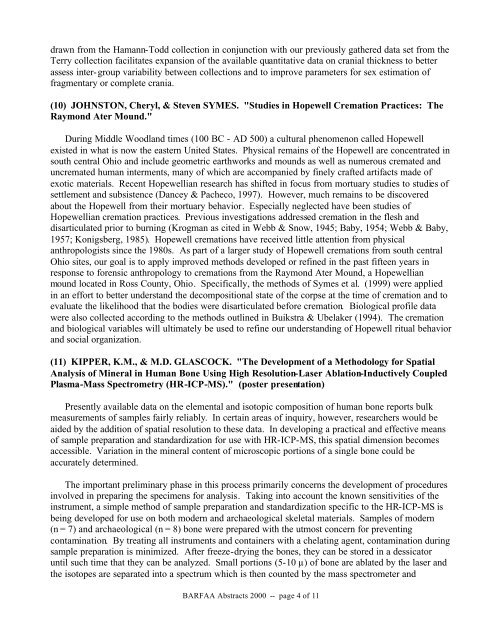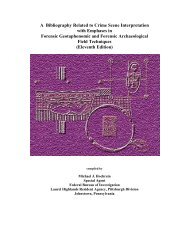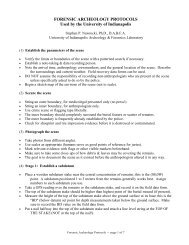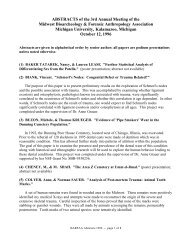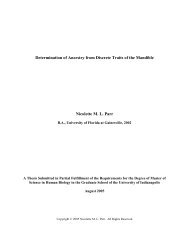Abstracts - University of Indianapolis Archeology & Forensics ...
Abstracts - University of Indianapolis Archeology & Forensics ...
Abstracts - University of Indianapolis Archeology & Forensics ...
You also want an ePaper? Increase the reach of your titles
YUMPU automatically turns print PDFs into web optimized ePapers that Google loves.
drawn from the Hamann-Todd collection in conjunction with our previously gathered data set from the<br />
Terry collection facilitates expansion <strong>of</strong> the available quantitative data on cranial thickness to better<br />
assess inter-group variability between collections and to improve parameters for sex estimation <strong>of</strong><br />
fragmentary or complete crania.<br />
(10) JOHNSTON, Cheryl, & Steven SYMES. "Studies in Hopewell Cremation Practices: The<br />
Raymond Ater Mound."<br />
During Middle Woodland times (100 BC - AD 500) a cultural phenomenon called Hopewell<br />
existed in what is now the eastern United States. Physical remains <strong>of</strong> the Hopewell are concentrated in<br />
south central Ohio and include geometric earthworks and mounds as well as numerous cremated and<br />
uncremated human interments, many <strong>of</strong> which are accompanied by finely crafted artifacts made <strong>of</strong><br />
exotic materials. Recent Hopewellian research has shifted in focus from mortuary studies to studies <strong>of</strong><br />
settlement and subsistence (Dancey & Pacheco, 1997). However, much remains to be discovered<br />
about the Hopewell from their mortuary behavior. Especially neglected have been studies <strong>of</strong><br />
Hopewellian cremation practices. Previous investigations addressed cremation in the flesh and<br />
disarticulated prior to burning (Krogman as cited in Webb & Snow, 1945; Baby, 1954; Webb & Baby,<br />
1957; Konigsberg, 1985). Hopewell cremations have received little attention from physical<br />
anthropologists since the 1980s. As part <strong>of</strong> a larger study <strong>of</strong> Hopewell cremations from south central<br />
Ohio sites, our goal is to apply improved methods developed or refined in the past fifteen years in<br />
response to forensic anthropology to cremations from the Raymond Ater Mound, a Hopewellian<br />
mound located in Ross County, Ohio. Specifically, the methods <strong>of</strong> Symes et al. (1999) were applied<br />
in an effort to better understand the decompositional state <strong>of</strong> the corpse at the time <strong>of</strong> cremation and to<br />
evaluate the likelihood that the bodies were disarticulated before cremation. Biological pr<strong>of</strong>ile data<br />
were also collected according to the methods outlined in Buikstra & Ubelaker (1994). The cremation<br />
and biological variables will ultimately be used to refine our understanding <strong>of</strong> Hopewell ritual behavior<br />
and social organization.<br />
(11) KIPPER, K.M., & M.D. GLASCOCK. "The Development <strong>of</strong> a Methodology for Spatial<br />
Analysis <strong>of</strong> Mineral in Human Bone Using High Resolution-Laser Ablation-Inductively Coupled<br />
Plasma-Mass Spectrometry (HR-ICP-MS)." (poster presentation)<br />
Presently available data on the elemental and isotopic composition <strong>of</strong> human bone reports bulk<br />
measurements <strong>of</strong> samples fairly reliably. In certain areas <strong>of</strong> inquiry, however, researchers would be<br />
aided by the addition <strong>of</strong> spatial resolution to these data. In developing a practical and effective means<br />
<strong>of</strong> sample preparation and standardization for use with HR-ICP-MS, this spatial dimension becomes<br />
accessible. Variation in the mineral content <strong>of</strong> microscopic portions <strong>of</strong> a single bone could be<br />
accurately determined.<br />
The important preliminary phase in this process primarily concerns the development <strong>of</strong> procedures<br />
involved in preparing the specimens for analysis. Taking into account the known sensitivities <strong>of</strong> the<br />
instrument, a simple method <strong>of</strong> sample preparation and standardization specific to the HR-ICP-MS is<br />
being developed for use on both modern and archaeological skeletal materials. Samples <strong>of</strong> modern<br />
(n = 7) and archaeological (n = 8) bone were prepared with the utmost concern for preventing<br />
contamination. By treating all instruments and containers with a chelating agent, contamination during<br />
sample preparation is minimized. After freeze-drying the bones, they can be stored in a dessicator<br />
until such time that they can be analyzed. Small portions (5-10 µ) <strong>of</strong> bone are ablated by the laser and<br />
the isotopes are separated into a spectrum which is then counted by the mass spectrometer and<br />
BARFAA <strong>Abstracts</strong> 2000 -- page 4 <strong>of</strong> 11


